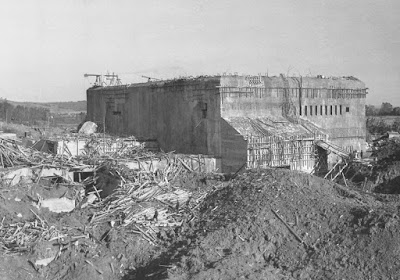The German Army sponsored the development of German long range artillery with the initiation of the A4 missile program in 1936. The first launch of the A4 at the Peenemunde test centre in March 1942 failed.
The first successful launch occurred in October the same year. The production program was initiated a month later, the A4 being predesignated as the V2.
 |
| V2 Rocket firing Peenemunde |
 |
| V2 Rocket firing Peenemunde |
 |
| V2 Rocket Engine |
The components when assembled were 14m (46 feet) in length, 1.65m (5 1/2 feet) in diameter.
The V2 rocket had a range of 320km (200 miles). Launched form a vertical position it would reach an altitude of 206 km (128 miles) at the apex of it's trajectory. Gyroscopes controlled the direction to the target along it's flightpath. A gyroscope accelerometer controlled the range, shutting off fuel when the rocket reached the target. The rocket would then plummet silently to earth, it's warhead exploding on impact.
 |
| V2 Rocket in flight |
 |
| V2 Impact |
The V2 Rocket could be launched from a mobile site. The rocket and launch vehicles would be taken to an appropriate location, the rocket erected into the vertical position and fired.
 |
| V2 Mobile Launch Site |
 |
| V2 Mobile Launch Site Equipment |
A limiting factor was the requirement for liquid oxygen (LOX) which evaporated rapidly during transportation, consequently proximity to LOX production facilities would increase the LOX available and therefore increase the rate at which rockets could be fired.
Hitler favoured static locations and ordered the building of permanent launch sites with integral LOX production and assembly facilities for the components. The chosen location was the Pas de Calais, the closest occupied territory to Britain and therefore providing the greatest operational range.
The construction of the Blockhaus at Wattens commenced in March 1943, the aim was to have the facility fully operation by November 1943. The facility included V2 Rocket assembly and serving areas, liquid oxygen production plant, and two external launching platforms.
 |
| Blockhaus - Wattens |
 |
| Blockhaus - Wattens |
 |
| Blockhaus - Wattens |
The Blockhaus came to the attention of the Allies in May 1943 when its presence was discovered during photo reconnaissance missions over the Pas-de-Calais.
 |
| Blockhaus Wattens Ariel Photograph |
 |
| Watten Site Target Map |
On 27th August 187 Flying Fortresses dropped 336, 2,000 pound bombs on the Blockhaus. As a result of the raid Hitler ordered the construction of another site 22km (13 miles) away at Wizernes.
The Watten Blockhause site was attacked four more times over the next month. The raids were effective in stopping the full construction of the facility.
The Germans then concentrated on using the Blockhaus for the production of liquid oxygen. The construction of LOX plant was completed in January 1944. The Allies did not have a bomb able to penetrate the 5ft thick reinforced concrete until June 1944. The RAF mounted two raids in June and July 1944 dropping 32 12,000 pound Tall Boy bombs. Only one bomb hit the bunker, but the earth quake effect was enough to disrupt LOX production.
 |
| RAF dropping Tall Boy Bomb |
 |
| Blockhaus Watten bomb damage |
The plant was abandoned on 18th July 1944.
The Germanns had attempted the construction of two permanent V2 sites, the Blockhaus at Watten and the Cupola and Wizernes. The efforts of the Royal Air Force and the United States Army Airforce resulted in no V2 Rockets being launched form the Pas De Calais.
The Allied advance form the Normandy bridgehead into the Pas De Calais forced the Germans to look at using mobile launch sites in the Netherlands. The first site was erected in the Hague on the 6th September 1944. On the 8th the first V2 rocket landed on London.
LE BLOCKHAUS D'ÉPERLECQUES
 |
| Blockhaus 2019 |
 |
| Blockhaus Plan |
 |
| Blockhaus 2019 V2 Storage Area damage |
 |
| Blockhaus 2019 V2 Storage Area damage |
 |
| Blockhaus 2019 V2 Storage Area |
 |
| Blockhaus 2019 Servicing Hall for Rocket Preparation |
 |
| Blockhaus 2019 Liquid Oxygen Production Plant |
 |
| Blockhaus 2019 Transit Hall towards Outside Firing pads |
 |
| Blockhaus 2019 Launch Area and Control Tower |
 |
| Blockhaus 2019 Transit Entrance Blocked Up |
 |
| Blockhaus Model showing V2 Storage Area |
































